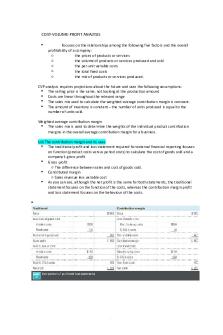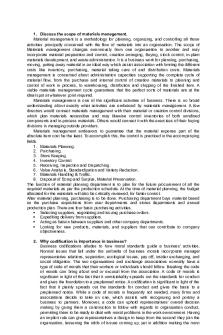Chapter 5 Scope Management PDF

| Title | Chapter 5 Scope Management |
|---|---|
| Course | Project IBA |
| Institution | Tilburg University |
| Pages | 6 |
| File Size | 154.4 KB |
| File Type | |
| Total Downloads | 86 |
| Total Views | 204 |
Summary
Project scope everything about a project—work content as well as expected outcomes. consists of naming all activities to be performed, the resources consumed, and the end products that result, including quality standards Conceptual development - Finding ways to tackle project objectivesBusiness Case...
Description
Project scope - everything about a project—work content as well as expected outcomes. - consists of naming all activities to be performed, the resources consumed, and the end products that result, including quality standards
Conceptual development - Finding ways to tackle project objectives Business Case - company’s (or project sponsor’s) best argument for undertaking a project - Whenever a company intends to commit capital or its resources to a project, it should be clearly in support of a demonstrable business need (1) demonstrate the business need for a given project, (2) confirm the project is feasible before expending significant funding, (3) consider the strategic internal and external forces affecting the project (refer to the TOWS matrix discussion from Chapter 2), (4) assess and compare the costs (both monetary and nonmonetary) of choosing the project over other courses of action (5) provide time estimates for when we expect to be spending investment money on the project
(6) risks from not doing the project!!!! Problem Statement
-
-
should be kept simple and based on clearly understood needs in search of solutions A key part of the problem statement is the analysis of multiple alternatives. Locking in “one best” approach for solving a problem too early in a project can lead to failure downstream “improve the processing speed of the computer by 20%” is much better than a goal that charges a project team to “significantly increase the performance of the computer.”
SOW Purpose - Can be vague, or highly complex (US Defense) - moves from the general to the specific, first articulating the project’s background, including a brief history of the reasons the project is needed, and then identifying the component tasks before moving to a more detailed discussion of each task objective and the approach necessary to accomplish it
-
-
The Statement of Work is important because it typically serves as the summary of the conceptual development phase of the project plan. Once armed with the SOW, the project manager can begin moving from the general to the more specific, identifying the steps necessary to adequately respond to the detailed SOW
The SOW covers the critical elements in a project proposal, including description, deliverables, resource requirements, risks, expected outcomes, estimated time and cost constraints, and other pending issues 1. Introduction and background—a brief history of the organization or introduction to the root needs that identified the need to initiate a project. Part of the introduction should be a problem statement 2. Technical description of the project—an analysis, in clear terms, of the envisioned technical capabilities of the project or technical challenges the project is intended to resolve. 3. Timeline and milestones—a discussion of the anticipated time frame to completion and key project deliverables (outcomes) Project Charter - Followed by SOW - a charter is created once the project supporters have done the needed “homework” - demonstrates formal company approval of the project and that can only occur when all necessary information during conceptual development has been satisfied
Scope Statement -
reflects a project team’s best efforts at creating the documentation and approval of all important project parameters prior to proceeding to the development phase
Establishing the project goal criteria. Goal criteria include cost, schedule, performance and deliverables, and key review and approval “gates” with important project stakeholders (particularly the clients). deliverables are formally defined as “any measurable, tangible, verifiable outcome, result, or item that must be produced to complete a project or part of a project.” The goal criteria serve as the key project constraints and targets around which the project team must labor. • Developing the management plan for the project. The management plan consists of the organizational structure for the project team, the policies and procedures under which team members will be expected to operate, their appropriate job descriptions, and a well-understood reporting structure for each member of the team. The management plan is essentially the project’s bureaucratic step that creates control systems to ensure that all team members know their roles, their responsibilities, and professional relationships. • Establishing a Work Breakdown Structure. One of the most vital planning mechanisms, the work Breakdown structure (wBs), divides the project into its component substeps in order to begin establishing critical interrelationships among activities. Until a project has gone through WBS, it is impossible to determine the relationships among the various activities (which steps must precede others, which steps are independent of previous tasks, and so on). As we will see, accurate scheduling can begin only with an accurate and meaningful Work Breakdown Structure. • Creating a scope baseline. The scope baseline is a document that provides a summary description of each component of the project’s goal, including basic budget and schedule information for each activity. Creation of the scope baseline is the final step in the process of systematically laying out all pre-work information, in which each subroutine of the project has been identified and given its control parameters of cost and schedule. Work Breakdown Structure (WBS) - is “a deliverable-oriented grouping of project elements which organizes and defines the total scope of the project. Each descending level represents an increasingly detailed definition of a project component a process that sets a project’s scope by breaking down its overall mission into a cohesive set of synchronous, increasingly specific tasks - a method for breaking a project up into “bite-sized” pieces, each representing a step necessary to complete the overall project plan.
WBS Purpose 1. It echoes project objectives. Given the mission of the project, a WBS identifies the main work activities that will be necessary to accomplish this goal or set of goals. What gets mentioned in the WBS is what gets done on the project. 2. It is the organization chart for the project. Organization charts typically provide a way
to understand the structure of the firm (who reports to whom, how communication flows evolve, who has responsibility for which department, and so forth). A WBS offers a similar logical structure for a project, identifying the key elements (tasks) that need attention, the various subtasks, and the logical flow from activity to activity. 3. It creates the logic for tracking costs, schedule, and performance specifications for each element in the project. All project activities identified in the WBS can be assigned their own budgets and performance expectations. This is the first step in establishing a comprehensive method for project control. 4. It may be used to communicate project status. Once tasks have been identified and responsibilities for achieving the task goals are set, you can determine which tasks are on track, which are critical and pending, and who is responsible for their status. 5. It may be used to improve overall project communication. The WBS not only dictates how to break the project into identifiable pieces, but it also shows how those pieces fit together in the overall scheme of development. As a result, team members become aware of how their component fits into the project, who is responsible for providing upstream work to them, and how their activities will affect later work. This structure improves motivation for communication within the project team, as members wish to make activity transitions as smooth as possible. 6. It demonstrates how the project will be controlled. The general structure of the project demonstrates the key focus that project control will take on. For example, is the project based on creating a deliverable (new product) or improving a process or service (functional efficiency) within the firm? Either way, the WBS gives logic to the control approach and the most appropriate control methods.
level WBS term Description Level 1 (Highest) Project The overall project under development Level 2 Deliverable The major project components Level 3 Subdeliverable Supporting deliverables Level 4 (Lowest) Work package Individual project activities Work Packages - defined as WBS elements of the project that are isolated for assignment to “work centers” for accomplishment. WBS codes - assigned to each activity to allocate costs more precisely - to track the activities that are over or under budget, and to maintain financial control of the development process Unlike work packages, sub-deliverables do not have a - duration of their own - consume resources - or have direct assignable costs
-
Any resources or costs attached to a sub deliverable are simply the summary of all the work packages that support it
Responsibility Assignment Matrix (RAM) identify team personnel who will be directly responsible for each task in the project’s development - identifies where each person can go for task support, who should be notified - of the task completion status at each stage, and any sign-off requirements This tool provides a clear linkage among all project team members - combats the danger of a potential communication vacuum in which project team members perform their own tasks without updating others - on the project team. -
5.3 Work Authorization -
stated terms for project development The manager must draw up contracts that clearly stipulate the work agreed to the nature of the project development process steps to resolve disputes and clearly identified criteria for successfully completing the project This specificity can be especially important when dealing with external stakeholders, including suppliers and clients
5.4 Scope Reporting - Determines types of information that will be regularly - reported - who will receive copies of this information - how this information will be acquired and - disseminated
Cost status: updates on budget performance - S curves: graphical displays of costs (including labor hours and other costs) against project schedule - Earned value: reporting project status in terms of both cost and time (the budgeted value of work performed regardless of actual costs incurred) - Variance or exception reports: documenting any slippages in time, performance, or cost against planned measures Schedule status: updates on schedule adherence Technical performance status: updates on technical challenges and solutions Configuration Management - Systematic management and control of project change (PMBoK) defines configuration management as “a system of procedures that monitors emerging project scope against the scope baseline. It requires documentation and management approval on any change to the baseline.” A baseline is defined as - the project’s scope fixed at a specific point in time - for example, the project’s scheduled start date. - The baseline, therefore, is viewed as the project’s configuration.
5.6 Project Closeout
(1) in the case of contractual disputes after the project has been completed, since the more thorough the project records, the less likely it is that the organization will be held liable for alleged violations; (2) as a useful training tool for post project analysis of either successes or failures; (3) to facilitate project auditing tasks by showing the flow of expenses in and out of various project accounts....
Similar Free PDFs

Chapter 5 Scope Management
- 6 Pages

Scope Management Plan
- 9 Pages

Project Scope management
- 5 Pages

Chapter 5 (Knowledge Management)
- 24 Pages

Strategic Management Chapter 5 ppt
- 18 Pages

CVP MANAGEMENT Chapter 5 summary
- 8 Pages
Popular Institutions
- Tinajero National High School - Annex
- Politeknik Caltex Riau
- Yokohama City University
- SGT University
- University of Al-Qadisiyah
- Divine Word College of Vigan
- Techniek College Rotterdam
- Universidade de Santiago
- Universiti Teknologi MARA Cawangan Johor Kampus Pasir Gudang
- Poltekkes Kemenkes Yogyakarta
- Baguio City National High School
- Colegio san marcos
- preparatoria uno
- Centro de Bachillerato Tecnológico Industrial y de Servicios No. 107
- Dalian Maritime University
- Quang Trung Secondary School
- Colegio Tecnológico en Informática
- Corporación Regional de Educación Superior
- Grupo CEDVA
- Dar Al Uloom University
- Centro de Estudios Preuniversitarios de la Universidad Nacional de Ingeniería
- 上智大学
- Aakash International School, Nuna Majara
- San Felipe Neri Catholic School
- Kang Chiao International School - New Taipei City
- Misamis Occidental National High School
- Institución Educativa Escuela Normal Juan Ladrilleros
- Kolehiyo ng Pantukan
- Batanes State College
- Instituto Continental
- Sekolah Menengah Kejuruan Kesehatan Kaltara (Tarakan)
- Colegio de La Inmaculada Concepcion - Cebu









